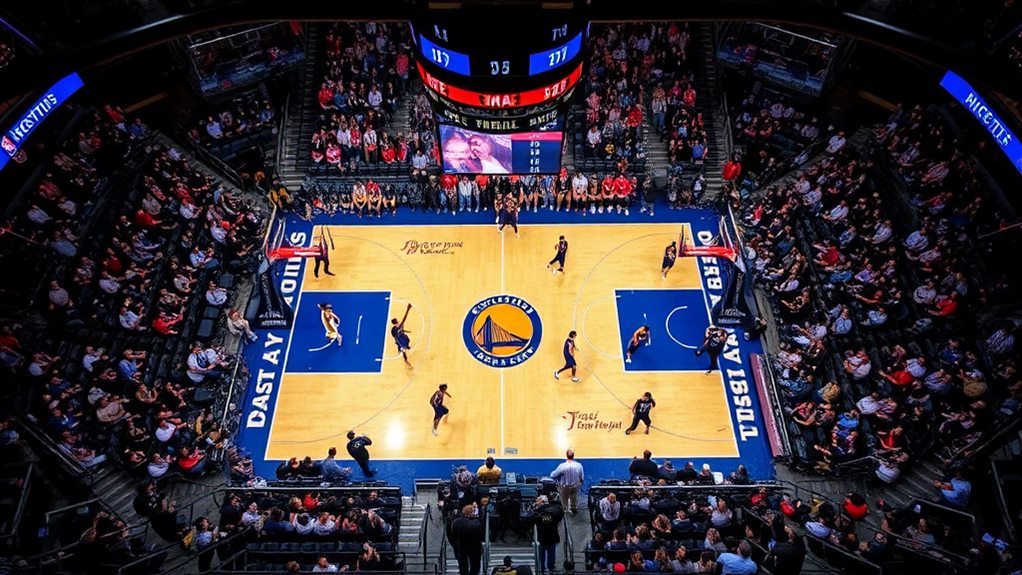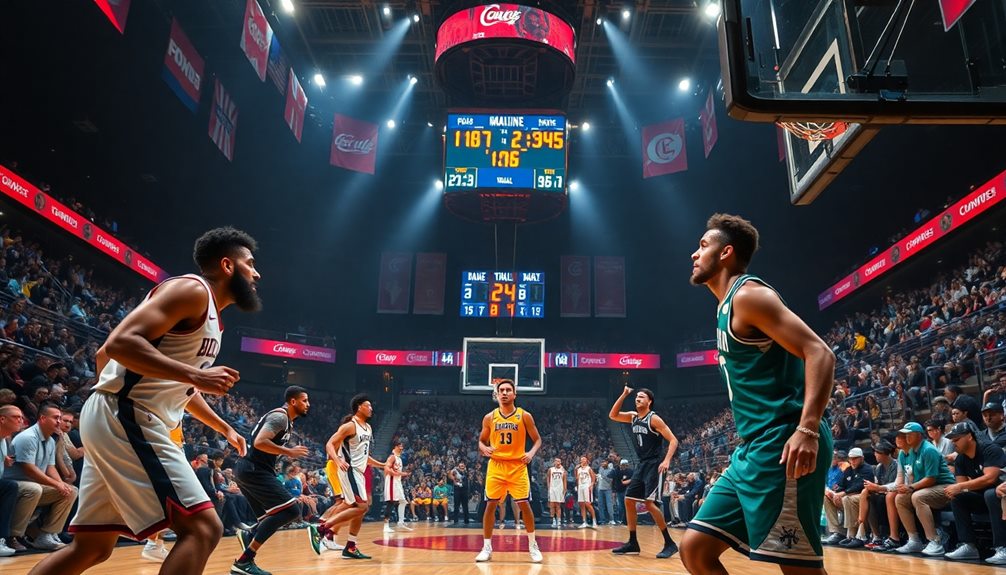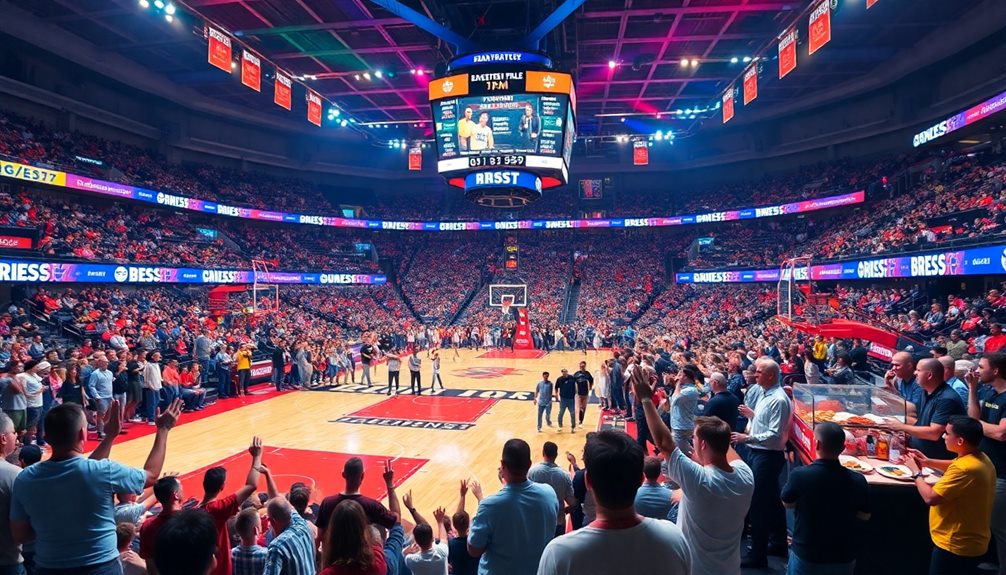
How Long Do NBA Games Last Including Breaks?
December 7, 2024An NBA game lasts about 2.5 hours when you factor in breaks, although the actual playing time is just 48 minutes. Each game is split into four quarters of 12 minutes each. You'll notice breaks between these quarters lasting around 2.5 to 3.5 minutes, plus a 15-minute halftime. Teams can also call timeouts, which adds to the overall time. If the score is tied, overtime periods of 5 minutes can extend the game even more. Understanding these elements makes watching a game even more exciting, and there's plenty more to explore about what affects the game's pacing.
Overview of NBA Game Duration
Understanding the duration of NBA games helps you better appreciate the flow and excitement of basketball. Each game consists of four quarters, with each quarter lasting 12 minutes, adding up to a total playing time of 48 minutes.
However, the average duration of an NBA game stretches to about 2.5 hours from tip-off to the final whistle. This extended time includes various breaks and stoppages, similar to the field dimensions and equipment requirements that structure the game of soccer.
During the game, you'll notice regular intervals between quarters lasting 2 minutes and 30 seconds, while nationally televised games may stretch this to 3 minutes and 30 seconds. Halftime, which lasts 15 minutes, gives teams a chance to regroup and strategize.
If the score is tied at the end of regulation, you'll see overtime periods, each lasting 5 minutes, further extending the game duration.
Additionally, timeouts can cause further delays, contributing to the overall length of the game. So, while the actual game time is 48 minutes, the total experience can be considerably longer, filled with moments of tension and excitement that keep fans on the edge of their seats.
Factors Affecting Game Length
Several factors contribute to the overall length of an NBA game beyond the 48 minutes of play. While the game consists of four quarters, the actual game length often stretches to about 2.5 hours due to various breaks and stoppages. This extended duration allows teams to utilize data-driven strategies for improved performance, as analytics-driven insights inform coaching decisions during these pauses.
Here are some key elements that affect the total duration:
- Halftime: The 15-minute halftime break gives teams time to regroup and strategize, extending the game time.
- Timeouts: Each team can call up to seven timeouts, especially in critical moments, considerably adding to the game length.
- Stoppages: Fouls, free throws, injuries, and video reviews pause the game clock, contributing to a longer viewing experience.
- Overtime: If the game is tied at the end of regulation, overtime periods of 5 minutes each can further increase the total game length, particularly if multiple overtimes occur.
These elements combined guarantee that while the game consists of only 48 minutes of actual play, the breaks and stoppages make your overall viewing experience much longer. Understanding these factors can help you better appreciate the pacing of an NBA game.
Overtime and Its Impact

When a game is tied at the end of regulation, overtime can greatly change the outcome and overall excitement of an NBA matchup. Overtime lasts for 5 minutes and is a thrilling opportunity for teams to secure a win. During this period, each team gets two additional timeouts, plus any remaining timeouts from regulation time, allowing for well-planned strategic play.
The importance of maintaining discipline during these critical moments can be likened to how yellow cards serve as reminders in soccer to uphold sportsmanship and respect for the game. yellow cards communicate unacceptable behavior to players, ensuring that teams remain focused and disciplined even in high-pressure situations.
The game clock is stopped during overtime, just like in regulation time, which means players can focus on executing their game plan without the constant pressure of a running clock. If the score remains tied after the first overtime, additional overtime periods keep rolling until a winner is found. This can lead to some nail-biting finishes and extended play that fans love.
The longest NBA game in history took place on January 6, 1951, featuring six overtime periods and totalizing an incredible 78 minutes of play. The Olympians edged out the Royals 75-73, showcasing how overtime can greatly impact not only the game's duration but also its intensity and excitement.
Game Structure Across Leagues
Across various basketball leagues, game structures differ considerably, affecting how the game is played and experienced. Understanding these differences can enhance your viewing experience and appreciation for the sport. Here's a breakdown of the game structures in different leagues:
- NBA Games: Composed of four quarters lasting 12 minutes each, totaling 48 minutes of game time. There's a 15-minute halftime break that allows teams to regroup, similar to how strategic options can shift in best soccer formations throughout a match.
- NCAA Basketball: The men's games feature two 20-minute halves, while the women's games are structured in four 10-minute quarters. This variation impacts the pace and strategy of the game.
- FIBA Games: Played in four quarters that last 10 minutes each, resulting in a total of 40 minutes of game time. This shorter duration can lead to a faster game pace.
- High School Basketball: Typically consists of four 8-minute quarters, with variability in halftime and breaks based on local regulations. This structure often caters to younger players' stamina and skill levels.
Each of these formats offers a unique length of a game and influences how you experience basketball at different levels, from youth leagues to professional play.
Enhancing Fan Engagement Strategies

To truly elevate the fan experience during NBA games, teams should consistently explore innovative engagement strategies. With each game lasting about 2 to 2.5 hours, there's ample opportunity to enhance fan engagement during halftime breaks, timeouts, and other stoppages.
Engaging and welcoming fans can considerably enrich the overall atmosphere, fostering a sense of belonging and community among attendees. Halftime, lasting 15 minutes, can be packed with contests and performances that captivate the audience, creating a supportive environment that encourages repeat attendance.
During the seven available timeouts, teams can creatively involve fans through sponsored activities and promotions, making each pause a chance for interaction. Short breaks between quarters, about 2 to 3 minutes long, can be transformed into moments of in-arena entertainment, showcasing local talent or fun games that keep the energy high.
Additionally, integrating merchandising opportunities during these breaks can boost revenue while giving fans a chance to grab their favorite gear. Implementing interactive experiences—like live polls or social media shout-outs—during stoppages can considerably enhance the game atmosphere, driving deeper fan engagement.
Conclusion
In the grand theater of basketball, an NBA game isn't just a sprint; it's a carefully choreographed dance of strategy and skill. With breaks and potential overtime, you're looking at around two and a half hours of excitement. But don't just watch the clock—immerse yourself in the action! Like a great novel, each game unfolds with twists and turns, keeping you on the edge of your seat. So grab your popcorn and enjoy the show!


